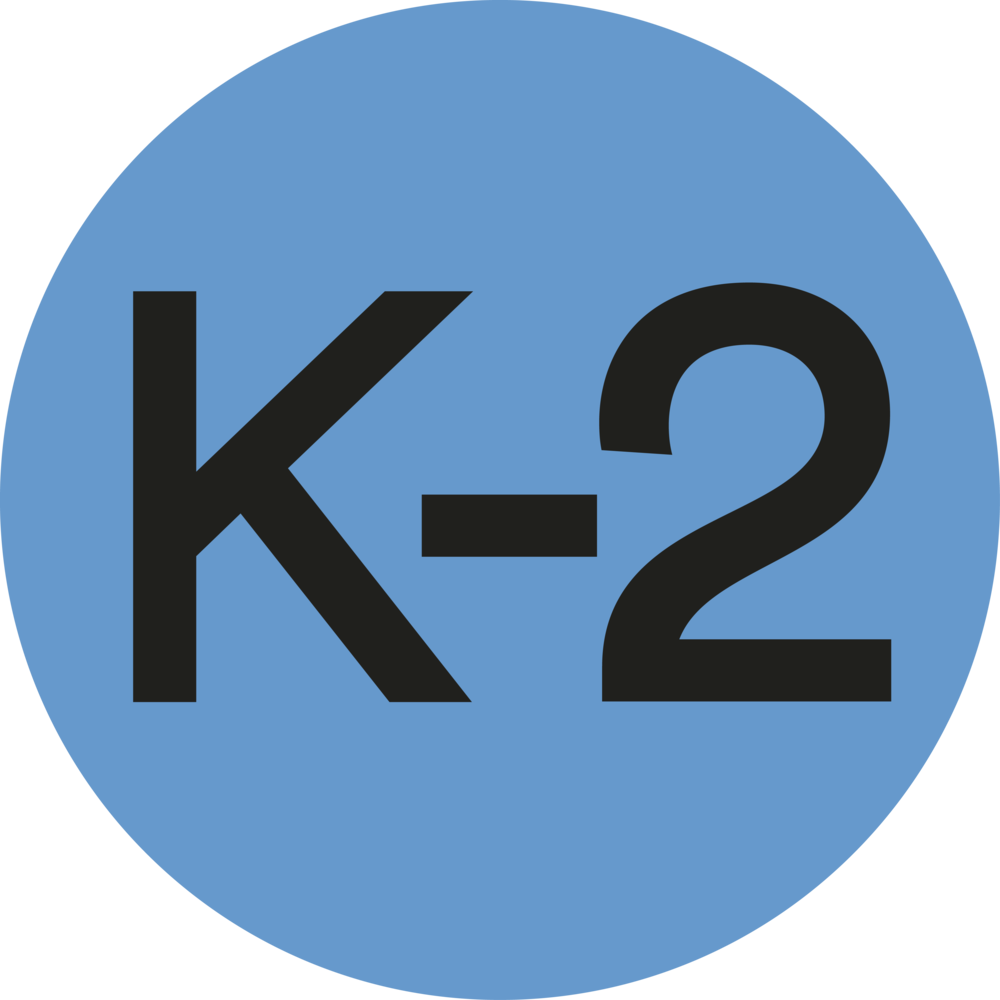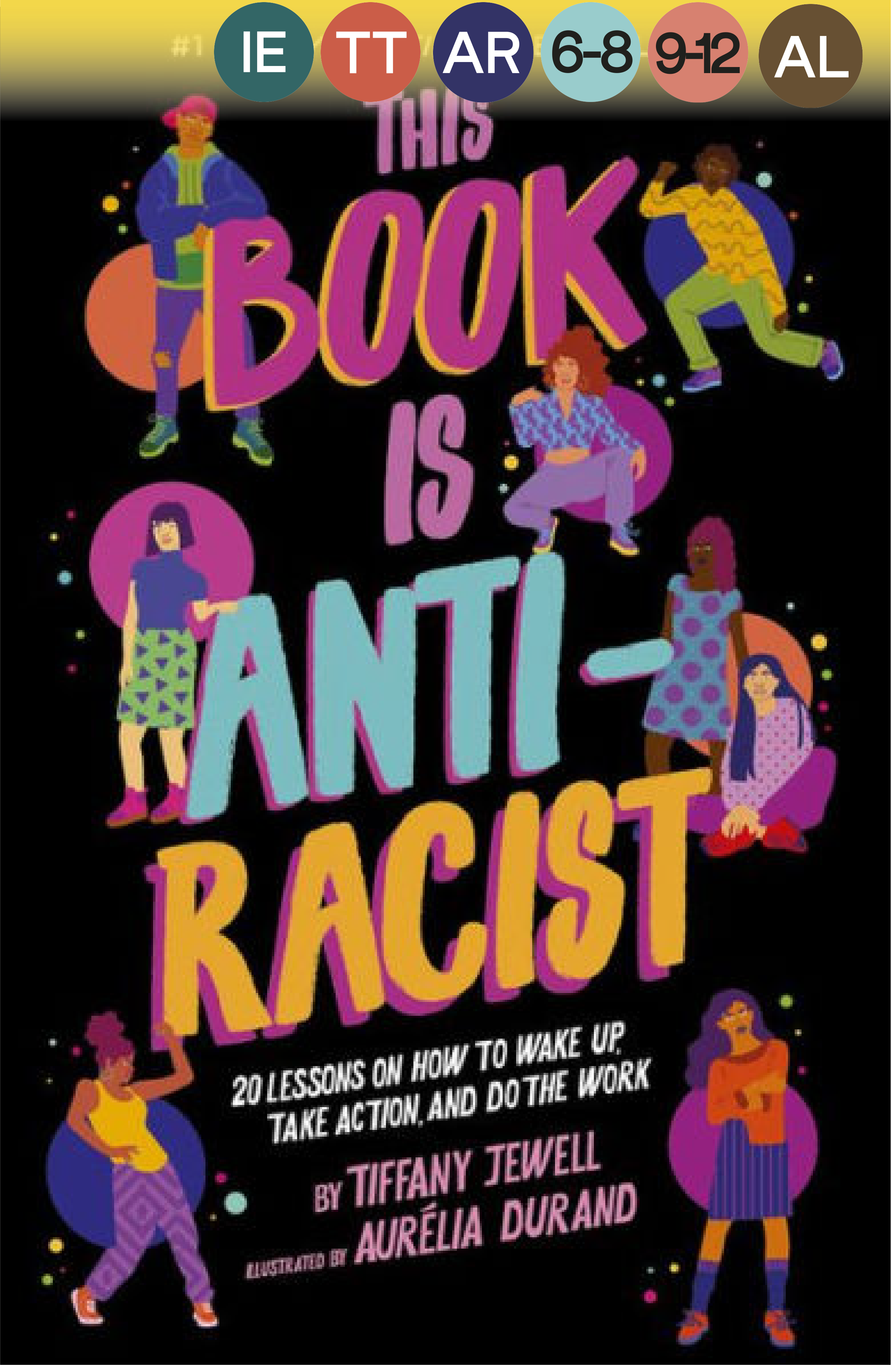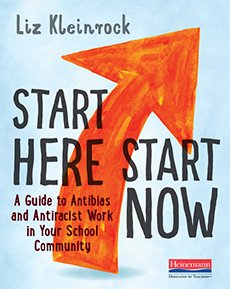Book Guide
Read our favorite books on anti-racism and teaching.
Key










This Book Is Anti-Racist:
20 Lessons on How to Wake Up, Take Action, and Do the Work
Written by Tiffany Jewell
Illustrated by Aurelia Durand
This Book is Anti-Racist is yet another example of a book that is intended for young adult audiences, but delightful for all ages. Aurélia Durand’s illustrations captivate. The sections in the book align with the goals of anti-bias education. The first focus is on understanding identity, and then it ends with an emphasis on anti-racist action. This is a book to return to over and over again. It can be used by an individual to grow in their own anti-racist practice, as a workshop guide, or as curriculum in the classroom. Jewell’s background as Montessori educator shines with clear explanations of topics like the tension that exists between “calling in” and “calling out,” or the internalized racism that can result after repeated microaggressions. The academic and intellectual is interwoven with her personal journey as a Black biracial woman, and opportunities to process and reflect abound. There is an educator guide on anti-biasmontessori.com.
Being The Change
Lessons and Strategies to Teach Social Comprehension
Written by Sara K. Ahmed
The lessons and strategies in Being the Change are explicit, simple, and adaptable. They include mentor texts, charting and discussion ideas, AND advice about what to do when students aren’t responding in the way you’d expect (spoiler alert, center the child and get out of your own head). An excellent component of this text is the way that Ahmed takes really basic tried and true ABAR practices like identity mapping, and embeds within them a powerful explanation as to WHY we engage in these explorations. We follow the arc of this work to affirm ourselves, place ourselves in the broader context of the world, become better informed, and understand other perspectives. Schools talk a good line about creating global citizens or cooperative humans, but the complex skill of engaging with people that are different from us is just that-- both complex and a skill. Being the Change provides tools to build the skills while also honoring the complexities.This book is entirely accessible. It will be useful to those who are beginning to implement ABAR practices into their classroom, as well as those who are well on their way.
My notes on this text are a text themselves. The language around impact vs. intent and the purpose of communication has been a tool in EVERY school community that I’ve worked with this spring, private, public, independent, and university.
I spoke to a school leader recently who expressed that the teachers in their school community that are inhabiting ABAR practices well are those who have been on a journey towards increased inclusivity, justice, and belonging for years. This book is for them. He also expressed that teachers who are struggling are those who cannot envision where to begin. They are still figuring it out. This book is for them, too.
Like everything, Being the Change is not perfect. Don’t read this book and borrow the lessons without first doing an examination of yourself and your classroom. For example, one lesson in this book includes imagery of Indigenous people as mascots that might not be the right approach for your school community or grade level. When books that develop us professionally offer us concrete tools, and we’re crunched for time, it can be easy to latch onto those tools and use them verbatim. Anti-bias and anti-racist classrooms will always require more. -Christina
Raising Multiracial Children:
Tools for Nurturing Identity in a Racialized World
Written by Farzana Nayani
The title of this book might make one initially think that it’s written for parents, but as you read on, it becomes clear that Nayani is writing about “raising” children in the sense of the village. It encompasses both the role of caregivers in the home and those in institutions that serve children, especially teachers. Important aspects of this book include its explanation of monoracism, multiracial microaggressions, and the nuances and fluidity of multiracial identity. So why focus on multiracial children? Because today, one in seven children born in the US are multiracial, and free exploration of their multiple racial and ethnic identities leads to positive life outcomes.
Planet Omar: Accidental Trouble Magnet
Written by Zanib Mian
Illustrated by Nasaya Mafaridik
This middle grade book is fabulous. It’s decidedly not a graphic novel, but imagery is embedded in the text in a delightful way, and I find that it meets the needs of readers that crave language that is manipulative.
I saw parts of friends and family in the pages of this book; it simultaneously has windows and mirrors, and I think most kids will be able to connect to Omar or someone in his family and friend group. There are sibling relationships, and even Omar’s relationship with God. Religion is a central part of Omar’s identity, and the explicit explanations of his practice of Islam make this book even more endearing and impactful.
I like that this book can foster both quick text to self and text to world connections while also being an opportunity to explore big topics like bullying, moving, and universes of obligation. It balances the lightness of a loving family and burgeoning friendships with the heaviness of discrimination and stereotypes.
On the other hand, I’m wary of the way that the book positions Omar’s family to be open and continuously loving in the face of xenophobia. With kids in the 6-8 grade band, this might be a good topic to explore further.
Finally, while on an adventure on London’s underground, Omar encounters an unhoused person. The initial encounter eventually comes full circle, and serves as a metaphor for Omar’s own experiences being othered, but it could inadvertently reinforce stereotypes about people who are unhoused. If you have students who don’t have permanent housing (which is something we as educators can’t always know) make sure to bring counter-examples or just leave this one out of your library. -Christina
Start Here Start Now
A Guide to Antibias and Antiracist Work in Your School Community
Written by Liz Kleinrock
Liz Kleinrock is a teacher—so this book just makes sense. It’s a practical guide designed specifically to answer the questions teachers are asking the most—like, “How do I teach a mandated text that is problematic through an ABAR lens?” or “What does ABAR look like when most of my students are white?” The book includes support in making space for difficult conversations in the classroom including “call in” strategies. Kleinrock reminds us to never reinvent the wheel—her inquiry based tools are tangible, replicable, and revelatory.
I’m Still Here Black Dignity in A World Made for Whiteness
Written by Austin Channing Brown
This book is explicitly anti-racist. It is a love letter to Black people. It amplifies the voices of Black women. It’s beautiful and nuanced and became increasingly popular this summer, reminding me to read it again. During my first reading years ago, I was the chair of the Diversity Anti-Oppression and Belonging committee at my little one’s cooperative nursery school, and the book shepherded me through some challenging times. I specifically often returned to the interlude, “How to Survive Racism in an Organization that Claims to Be AntiRacist.” To be clear, needing this text as support is not a dig at that particular organization; if we understand being antiracist as a practice as opposed to a destination, one that is made up of a multitude of daily decisions that move us on a continuum toward liberation, then it makes sense that even (and especially) organizations that are working hard to be better will inevitably, at times, fall short. In the process of repair and reconciliation, this book is a tool that affirms the experiences of BIPOC people.
This book is like an embrace. It’s a memoir and a how-to and it humanizes us for us.
It’s important to note that Brown is a Christian, and writes from that perspective. Her work in nonprofit and religious organizations forms the basis of much of this reflection.
-Christina






